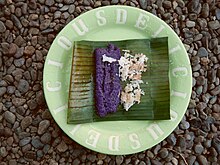Puto bumbong
 | |
| Alternative names | Puto bombong |
|---|---|
| Course | Dessert |
| Place of origin | Philippines |
| Serving temperature | Room temperature, hot |
| Main ingredients | Pirurutong glutinous rice, white glutinous rice, muscovado, grated coconut, butter/margarine, sesame seeds |
| Variations | puto |
| Similar dishes | kue putu, putu bambu, puttu |
Puto bumbong is a Filipino purple rice cake steamed in bamboo tubes. It is traditionally sold during the Christmas season. It is a type of puto (steamed rice cake).
Etymology
[edit]The name is derived from Tagalog puto (steamed rice cakes) and bumbong or bombong ("bamboo tube"). The names are sometimes mistakenly spelled as puto bungbong or puto bongbong.[1]
Description
[edit]
Puto bumbóng is made from a unique heirloom variety of glutinous rice called pirurutong (also called tapol in Visayan), which is deep purple to near-black in color.[2] Pirurutong is mixed with a larger ratio of white glutinous rice (malagkít or malagkít sungsong in Tagalog, lit. "Chinese glutinous rice"; pilit in Visayan).[3] Regular white rice may also be used instead of malagkít, to give the dish a less chewy consistency.[4]
The rice grains are covered completely in water (traditionally mixed with salt) and left to soak overnight. This gives it a slightly acidic, fermented aftertaste. The mixture is then drained and packed densely into bamboo tubes and steamed. The sides of the bamboo tubes are traditionally greased with coconut oil, but modern techniques use butter or margarine. The rice is traditionally cooked as whole grains, but in some recipes, the rice is ground before or after soaking.[5][4][6][7]
The resulting cylindrical rice cake is then served on banana leaves, slathered with more butter or margarine, seasoned with muscovado sugar, just brown sugar, white sugar, grated coconut, and sometimes sesame seeds. Less common toppings include condensed milk (as an alternative to sugars), grated cheese, and leche flan.[3][8]
Cultural significance
[edit]

Puto bumbóng is commonly served as a snack or breakfast dish during the Christmas season. It is usually associated with the nine-day traditional Simbáng Gabí devotion, where stalls serving snacks including puto bumbóng are set up outside churches before dawn.[9][5]
Variations
[edit]Modern puto bumbong may use metal cylinders or regular food steamers. These versions are commonly shaped into little balls or long narrow tubes (similar to suman).[9] In some modern versions, pirurutóng is excluded altogether as it can be hard to find, and purple food coloring or even purple yam (ube) flour are used instead. However, these versions may be frowned upon as being inauthentic.[5][4][6][10]
Adaptations of the dish in restaurants include ice-cream flavors, pancakes, cakes, and empanadas.[11]
A variant of puto bumbóng from the provinces of Batangas and Pampanga is putong sulot, which uses white glutinous rice. Unlike puto bumbóng, it is available year-round.[12]
Similar desserts
[edit]In Indonesia there is a very similar dessert known as kue putu in Indonesian. It is also cooked in bamboo tubes, but is made with rice flour. It is also commonly green due to the use of pandan leaves as flavoring.[13]
In India (Kerala, Tamil Nadu, and Karnataka) and Sri Lanka, a similar dish is known as puttu or pittu, though it is a savory dish rather than a dessert.[14]
Both of these related dishes are very different in that they use regular (non-sticky) rice flour or ground white rice, but they are all cooked in bamboo tubes.[13][14]
See also
[edit]References
[edit]- ^ "Bumbong". Tagalog Lang. Retrieved December 5, 2018.
- ^ "Puto Bumbong". The Freeman. 53 (152): 18. December 16, 2017.
- ^ a b Angelita M. del Mundo (1995). "Emerging Versions of Some Traditional Philippine Rice Food Products". In Harlan Walker (ed.). Disappearing Foods: Studies in Food and Dishes at Risk. Proceedings of the Oxford Symposium on Food and Cookery 1994. Prospect Books. p. 64. ISBN 9780907325628.
- ^ a b c "Puto Bumbong a la Marketman". Market Manila. December 16, 2007. Retrieved December 5, 2018.
- ^ a b c "Puto Bumbong". Gastro Obscura. Atlas Obscura. Retrieved December 5, 2018.
- ^ a b Amy Besa & Romy Dorotan (2014). Memories of Philippine Kitchens. Abrams. ISBN 9781613128084.
- ^ "How to Make Puto Bumbong (steamed glutinous rice)". Business Diary Philippines. August 11, 2017. Retrieved December 5, 2018.
- ^ "Puto Bumbong". Filipino Chow. December 23, 2017. Retrieved December 5, 2018.
- ^ a b Sastrillo, Berna (November 29, 2017). "The Search for the Best Puto Bumbong in Manila". ModernFilipina. Retrieved December 5, 2018.
- ^ Paguio, Renz Lyndon (December 2, 2014). "Home-based business idea: How to make puto-bumbong". Entrepreneur Philippines. Retrieved December 5, 2018.
- ^ Comsti, Angelo (December 2, 2014). "3 new delicious ways to enjoy Puto Bumbong". Coconuts Manila. Retrieved December 5, 2018.
- ^ Edgie Polistico (2017). Philippine Food, Cooking, & Dining Dictionary. Anvil Publishing, Incorporated. ISBN 9786214200870.
- ^ a b Anggara Mahendra (June 13, 2013). "'Kue Putu' Steamed Green Cake". Baily Daily. Archived from the original on June 15, 2015. Retrieved June 12, 2015.
- ^ a b "BBC Indian Food Made Easy: Recipe for puttu", BBC, archived from the original on December 24, 2008, retrieved August 13, 2010

